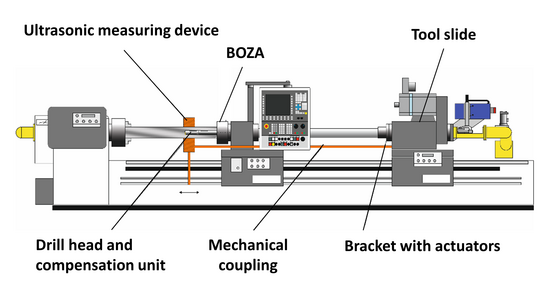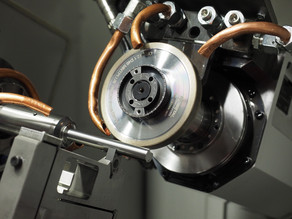Research and Development of a Mechatronic Tool System fort he Compensation of Straightness Deviation in BTA Deep Hole Drilling
BTA deep drilling is used in a diameter range of about d = 10...1500 mm in the different drilling variants of solid drilling, core drilling and counter boring. Characteristic features of this method are the asymmetrical design of the tool, the cooling lubricant supply with a high volume flow through a special drilling oil supply apparatus (BOZA) and the removal of the chips and the cooling lubricant through the drilling tube. BTA deep drilling is often used at the end of the value chain for the machining of expensive components such as hydraulic cylinders, gear shafts and aircraft landing legs. Therefore, a high process stability is of enormous technical and economic importance. As the drilling depth increases, the centreline of the generated bore often becomes a decisive quality feature. The straightness deviation is defined as the distance of the ideal to the actual drilling axis. Deep hole drilling usually results in a with the drilling depth increasing straightness deviation, which can lead to rejects depending on the requirements. In the industrial production of boreholes with a large length-to-diameter (l/D) ratio and low permissible tolerances of the straightness deviation, a time-consuming manual correction to reduce the straightness deviation has established itself. The drilling process is interrupted at regular intervals in order to measure the wall thickness on the tool head with an ultrasonic device. From the deviation of the wall thickness, the tilting of the drill head relative to the ideal drilling axis is deduced. The machine operator then changes the position of the drill head in such a way that the straightness deviation is reduced in the continued drilling process. In the case of stationary components, this is achieved by exchangeable pressure pieces with variable thickness, which support the drill pipe at the drill hole and impose a bending line on the drill pipe. This method of influencing the straightness deviation is currently based on the experience of the machine operators and is characterised by cost-intensive non-productive times.
The aim of the research project therefore is the development and research of a mechatronic tool system for the compensation of the straightness deviation. The system carries out the straightness deviation correction without a process interruption and can be retrofitted for existing deep drilling machines. On the basis of the knowledge gained in the preliminary tests and simulations, a mechatronic compensation unit is designed and will then be manufactured, which will enable the drill head to be displaced in a targeted manner. The process-parallel detection of the drill head position is carried out with an ultrasonic measuring system. Overall, the new tool system enables the productive production of high-quality bores with BTA deep drilling.





![[Translate to English:] [Translate to English:]](/storages/isf-mb/_processed_/a/1/csm_Wendel_Tiefbohrer_51a08eea1c.jpg)